Seeing Things: November 2008 Archives
New York City Ballet: The Nutcracker / New York State Theater, NYC / November 28, 2008 - January 3, 2009
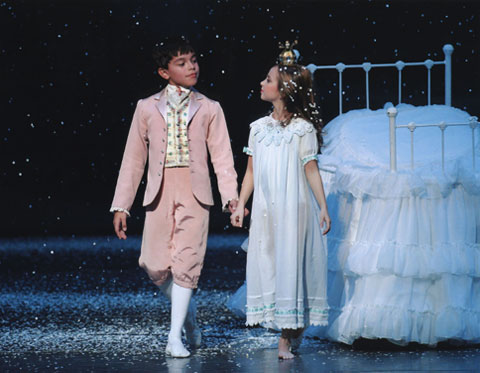
Marie awakens to witness startling transformations. The Christmas tree grows to gargantuan size. The toy soldiers, neatly arranged in a case in the drawing room grow to her own height and come to life to battle the mice. The bed that Drosselmeier's nephew earlier offered Marie for her broken Nutcracker magically scoots away as if of its own volition to be replaced by a life-size bed, and the Nutcracker, now grown as well, charges into battle to protect the terrified Marie. The changes of size and awakening to new powers hint at the physical and emotional processes of puberty, during which a child can seem to grow in body and soul overnight.
The full article appeared in Voice of Dance (http://www.voiceofdance.org) on November 26, 2008. To read it, click here.
This article originally appeared in the Culture section of Bloomberg News on November 21, 2008.
Nov. 21 (Bloomberg) -- The multiethnic, multicultural Complexions Contemporary Ballet, which opened its two-week season at New York's Joyce Theater on Tuesday, is devastatingly handsome and just as slick.
Founded in 1994 by former Alvin Ailey stars Dwight Rhoden and Desmond Richardson, the company is unlikely to change your life or lend you piercing insight into others' lives. So many sophisticated dance fans give it a pass (as they do several other highly popular troupes, such as Pilobolus Dance Theater).
However, Richardson, the company's leading man, is a real artist. Thought of as a modern dancer, he's comfortable with classical ballet as well.

Desmond Richardson, the star and co-founder of Complexions Contemporary Ballet, rehearses in the studio on Aug. 30, 2008. The troupe opened its two week season at New York's Joyce theater and will perform through Nov. 30. Photographer: Dah-len/Complexions Contemporary Ballet via Bloomberg News
Richardson's dancing has subtle qualities, including infinitely varied texture and the ability to animate the space he inhabits like a piece of moving sculpture. He also manages to convey authentic emotion through even the slightest choreographic scripts. So there's more to him than meets the eye, though it must be admitted he's also a hunk: tall, long-limbed, and exquisitely proportioned, with musculature to die for and lines whose default mode is perfect harmony.
A highlight of the current season is "I Will Not Be Broken," an extended solo with unusual accompaniment that Rhoden, the group's chief choreographer, created for Richardson, his muse. It's about surviving -- triumphing, even -- after one has hit bottom. Dramatically matched by Negro spirituals spoken and sung by actress S. Epatha Merkerson, it's also augmented by a duet for two other dancers who seem to be figments of Rhoden's memory.
Electrifying Presence
Rhoden writhes on and around a narrow wooden bench, making agonized gestures of pain, then eventually rises, reaching to the heavens, as if to reclaim his faith and, thus, his own salvation. Merkerson's self-contained yet still electrifying presence as she moves among the dancers makes the piece a theatrical event as much as a choreographic one.
The only other worthy piece on the program was Igal Perry's new "Constructs for 4," a graceful and gracious quartet for a woman and three men. It provides a softness, fluidity, and musical phrasing that Rhoden's choreography desperately lacks and some interesting passages of male-male partnering when the group work splinters into a double duet.
Velvety Touch
What made "Constructs" memorable and not simply pleasant was the dancing of Gary W. Jeter II, who might be a young clone of the mature Richardson. Perry gave him a long solo that contrasted difficult ballet steps, such as double turns in the air, with modern dance's melting falls to the floor, all of which Jeter executed with a velvety touch and modest manner. The company is blessed to have him.
Opening night also featured two over-long, over-populated pieces by Rhoden -- "Routines" and "Rise" -- and a brief one, "Ave Maria." The last was simply vulgar. The first two revealed Rhoden's weaknesses to an embarrassing degree. He arranges his dancers in simple geometric patterns that are cumulatively stultifying.
He has them move continuously with aggressive force as if at war with the world, even when, as in "Rise," encouraged by the music of U2, they're presumably ecstatic with the joy of life. He seems ignorant of the nature of flesh, with its sensuous pliancy. This alone, in a choreographer, is very bad news.
Through Nov. 30 at 175 Eighth Ave. Information: +1-212-242- 0800; http://www.joyce.org.
© 2008 Bloomberg L.P. All rights reserved. Reprinted with permission.
Bebe Miller Company: Necessary Beauties / Dance Theater Workshop, NYC / November 11-15, 2008
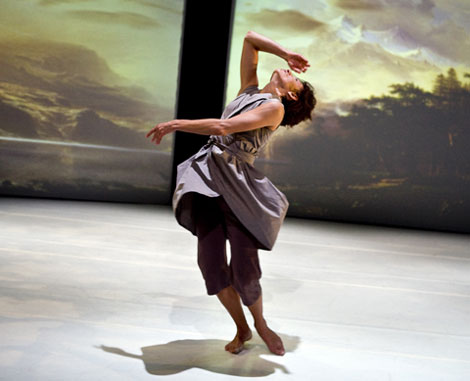
I remember the veteran dancer-choreographer Bebe Miller for two qualities: the ferocity of her performing--she was a wild, thrillingly unpredictable woman when she was dancing--and, later, for the choreography of a couple of pieces I saw that, with understanding and tenderness, focused on the humane aspects of the human race.
The full article appeared in Voice of Dance (http://www.voiceofdance.org) on November 13, 2008. To read it, click here.
This article originally appeared in the Culture section of Bloomberg News on November 7, 2008.
Nov. 7 (Bloomberg) -- The gala opening night of the 40-year-old Lar Lubovitch Dance Company, Wednesday, at New York's City Center, revealed a great deal of what we've come to expect of this choreographer: grace, lyricism, easy musicality, clear structure and sentimentality.
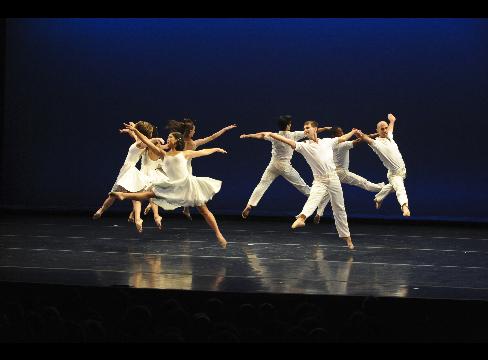
Members of the Lar Lubovitch Dance Company perform ``Concerto Six Twenty-Two,'' to music by Mozart in this undated handout photo released to the media on Thursday, Nov. 6, 2008. The company is performing at the New York City Center, 131 W. 55th St., through Nov. 9. Photographer: Christopher Duggan/Lar Lubovitch Dance Company via Bloomberg News
Lubovitch's work is pleasing, not challenging, certainly not confrontational; some find it banal. He presents lovely, accomplished dancers who reach occasional rhapsodic moments -- a key reason for his company's worldwide popularity, even if it isn't out to set your mind or soul on fire.
Of the three vintage works on the bill, ``Concerto Six Twenty-Two'' (1986, named for its Mozart score), gives you Lubovitch in a nutshell.
The first and last of its three sections are elated dances by a large group and segments of it that invariably link back to the full community. The choreography is distinctive for its ever- evolving circles, traced in turning patterns and individual swirling bodies. The effect is marred slightly by little bits of sophomoric tomfoolery, perhaps inserted purposely, as if to break up the otherwise relentless loveliness.
The mid-section, entirely disconnected from rest of the dance, is a tender, meditative male duet. It's a persuasive argument, if one is needed -- and it was, at the height of the AIDS epidemic -- to respect love between two men.
Dark Stunner
``North Star'' (1978, to Philip Glass) is a dark stunner that seems to be set in a night sky, with a galaxy breaking and re-forming as if inseparable for eternity. It moves on to a pulsing, witchy solo for a woman, then a calm, limb-stretching one for a man who summons the star-cluster back to surround him.
The earliest dance on the program, the 1969 ``Whirligogs,'' claims in its program note to have been inspired by Paul Taylor's simultaneously frightening and funny ``Three Epitaphs,'' a singular small masterpiece. It wasn't inspired enough.
Of the two recent dances shown, I preferred this year's ``Jangle,'' to Bartok music in his Slavic mode. An impromptu response to street music, it means to portray a middle-European, working class group from a decade long past.
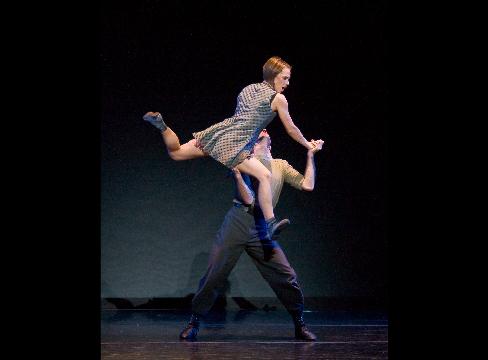
Kate Skarpetowska and Brian McGinnis of the Lar Lubovitch Dance Company perform "Jangle" to music by Bartok in this undated handout image released to the media on Thursday, Nov. 6, 2008. Photographer: Sharen Bradford/Lar Lubovitch Dance Company via Bloomberg News
It would look better if it felt more weighted and seemed more spontaneous. However its vivacity, tied to folk forms, and its varieties of mood increase as the dance progresses, and the music is irresistible. The piece has a marvelous duet for a troubled couple and cheeky bravado in Jonathan E. Alsberry's solo passages that suggest Lubovitch may be moving beyond his familiar boundaries.
Virginal White
The 2007 ``Dvorak Serenade'' is essentially another pretty dance, performed in virginal white. It's remarkable, though, for its leading couple: Mucuy Bolles (she of the still center) and Scott Rink as her sympathetic cavalier, who responds to her calm reticence and delicacy.
Lubovitch uses a lot of classical scores, as well as the stellar moderns (Philip Glass, Steve Reich) and suave vintage popular music (George Gershwin, Cole Porter). He is rarely in the forefront of new sound, though he was one of the first to use minimalist music.
When it comes to choreography, he is infinitely adaptable, working in several genres besides modern dance: among them ballet, musical theater, and ice dancing, that most self- contradictory of modes. He refuses to make sharp distinctions among dance forms or vocabularies; to him dancing is dancing and he's very competent at creating work from the sources he knows best. So what do you want? More? Yes.
Through Nov. 9 at 131 W. 55th St. Information: +1-212-581- 1212; http://www.lubovitch.org.
© 2008 Bloomberg L.P. All rights reserved. Reprinted with permission.
This article originally appeared in the Culture section of Bloomberg News on November 4, 2008.
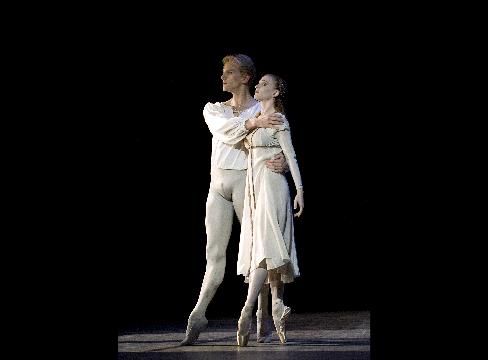
Gillian Murphy, right, and David Hallberg perform the pas de deux from "Romeo and Juliet (Romeo's Farewell)" during American Ballet Theatre's Tudor Centennial Celebration in New York on Oct. 21, 2008. The celebration runs at New York's City Center through Nov. 2. Photographer: Gene Schiavone/ABT via Bloomberg News
Nov. 4 (Bloomberg) -- The ability to reveal, through movement, the complex emotional life of a human being, was the supreme gift of Antony Tudor (1908-1987), whom American Ballet Theatre calls its own.
Closing out its fall season at New York's City Center this past weekend, ABT's Tudor Centennial Celebration presented a handful of works charting a career solidly begun in England and then continued in America.
Tudor was not prolific, he had his failures and he is nearly impossible to mount today. His ballets' profound effect demand extensive rehearsal time, his own coaching (which could be remorseless) and the willingness of the audience to recognize itself in the mirror his dances hold up to them. Nevertheless he remains a unique choreographer who stands indisputably among the dance geniuses of the 20th century.
The program included a pair of Tudor's most celebrated ballets. ``Jardin aux Lilas'' (``Lilac Garden''), made in England in 1936 and set in the Edwardian era, concerns an arranged marriage that breaks the hearts of a young woman, the youth she loves, the vehement abandoned mistress of ``the man she must marry'' and perhaps even that man himself, though his I-claim- you-as-my-rightful-property attitude masks it.
Set to Ernest Chausson music that swells with emotion, the action takes place at a garden party in which the heroine says farewell to her friends and her innocent, ardent lover, to depart, frozen, on the arm of the man who has acquired her. The ballet seems suffused with the delicate scent of blooming lilacs -- suggesting loveliness doomed to an early death. ABT gave it an admirable performance, with Julie Kent, as the heroine, at her tremulous best.
`Pillar of Fire'
``Pillar of Fire'' (1942) tells a spinster's story. Frustrated by Edwardian propriety and feeling herself devoid of sexual attraction, she offers herself up to a one-night-stand stud, then finally finds understanding, forgiveness for her ``sin'' and -- yes -- love, from the most ordinary-seeming man in the world. This is no fairy tale, though; the action moves from repressed emotion to turbulence to catharsis, leaving the sympathetic viewer shaken to the core. The secondary characters were oddly miscast, but Gillian Murphy's power in the central role was soul-wrenching.
Lighter in weight, yet piercing in its own way, the 1938 ``Judgment of Paris'' is a sardonic riff on the Greek myth of Paris, asked to choose the most beautiful or gifted of three goddesses. A progressively inebriated old gent loses both his valuables and his dignity in a seedy cafe, lured by a trio of ladies of the night who have seen far better days. The simultaneous combination of humor and tragedy is a feat few choreographers could bring off. The pathetic ``goddesses,'' danced by ABT alumnae, were positively Stanislavskian.
`Romeo and Juliet'
The tenderness of Tudor's 1943 one-act ``Romeo and Juliet'' is partly due to the choreographer's slyly avoiding the bombastic Prokofiev score. Tudor chose Delius and created a work that is exquisitely poignant and humane -- and considered all but lost today. The bedroom pas de deux, called ``Romeo's Farewell,'' has been retrieved, though, and more of the ballet may eventually resurface. Xiomara Reyes and Gennadi Saveliev were woefully illcast, but at the season's opening night gala, Murphy and David Hallberg were both expressive and precise, making every gesture count.
`Continuo'
Tudor made the 1971 ``Continuo'' for his students when he was teaching at Juilliard. It was danced here by their equivalent, newer members of the corps de ballet. Its three couples flow through space with the weightlessness of a dream, evoking the natural beauty and unself-conscious lyricism of the young.
Sadly, the masterwork of Tudor's late years, the plotless ``The Leaves Are Fading,'' was scrapped for lack of time. At least ``Leaves'' was performed earlier in the course of the season. In it, several young couples emerge from a small community in duets that evoke the variety of love's ecstasy. A less sophisticated choreographer would have made the piece dulcet. Tudor takes this quality for granted, subtly varies the duets' moods, and adds the intensity of rapture understood in retrospect.
ABT calls Tudor its ``artistic conscience'' and its stagers and dancers must have tried hard to make the present productions accurate and moving. Still a good deal more needs to be done, beginning by keeping the ballets active in the repertory, if the Tudor legacy is to survive. In a cruelly commercial society, the Tudor ballets don't ``sell'' anymore -- in part because ABT has taught audiences that his worlds of deep feeling and piercing insights into human nature are passe compared to the meaningless spastic gyrations of Jorma Elo.
© 2008 Bloomberg L.P. All rights reserved. Reprinted with permission.
Sitelines
AJ Ads
 360° Dance Company at DTW offers two socially relevant revivals, Jane Dudley’s solo “Time Is Money” (1932) and Mary Anthony’s “Devil in Massachusetts” (1952) as well as the World Premier of Artistic Director, Martin Lofsnes' "6-1".
360° Dance Company at DTW offers two socially relevant revivals, Jane Dudley’s solo “Time Is Money” (1932) and Mary Anthony’s “Devil in Massachusetts” (1952) as well as the World Premier of Artistic Director, Martin Lofsnes' "6-1".
AJ Blogs
AJBlogCentral | rssculture
Terry Teachout on the arts in New York City
Andrew Taylor on the business of arts & culture
rock culture approximately
Laura Collins-Hughes on arts, culture and coverage
Richard Kessler on arts education
Douglas McLennan's blog
Dalouge Smith advocates for the Arts
Art from the American Outback
Chloe Veltman on how culture will save the world
For immediate release: the arts are marketable
No genre is the new genre
David Jays on theatre and dance
Paul Levy measures the Angles
Judith H. Dobrzynski on Culture
John Rockwell on the arts
innovations and impediments in not-for-profit arts
Jan Herman - arts, media & culture with 'tude
dance
Apollinaire Scherr talks about dance
Tobi Tobias on dance et al...
jazz
Howard Mandel's freelance Urban Improvisation
Focus on New Orleans. Jazz and Other Sounds
Doug Ramsey on Jazz and other matters...
media
Jeff Weinstein's Cultural Mixology
Martha Bayles on Film...
classical music
Fresh ideas on building arts communities
Greg Sandow performs a book-in-progress
Harvey Sachs on music, and various digressions
Bruce Brubaker on all things Piano
Kyle Gann on music after the fact
Greg Sandow on the future of Classical Music
Norman Lebrecht on Shifting Sound Worlds
Joe Horowitz on music
publishing
Jerome Weeks on Books
Scott McLemee on books, ideas & trash-culture ephemera
theatre
Wendy Rosenfield: covering drama, onstage and off
visual
Public Art, Public Space
Regina Hackett takes her Art To Go
John Perreault's art diary
Lee Rosenbaum's Cultural Commentary
